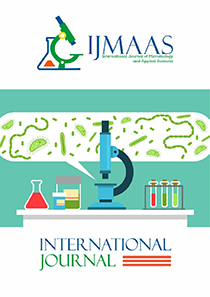Optimization and Production of Liquid Biofertilizer from Agro-Wastes using Microbial Cells
Vol 3, Issue 1, 2024
KEYWORDS
Liquid biofertilizer, poultry waste, plantain peel, bacteria, fungi, sustainable agriculture
Abstract
Biofertilizer is an important byproduct of fermentation and components of integrated nutrient management, as they are cost effective and renewable source of plant nutrients to supplement the chemical fertilizers for sustainable agriculture. This study is designed to optimize the production of liquid biofertilizer and enhance soil quality and plant productivity through the use of selected microorganisms. The organisms used for the liquid biofertilizer production were Aspergillus niger, Penicillium chrysogenum, Bacillus cereus, Bacillus licheniformis, Pseudomonas fluorescens and Azotobacter chroococcum. The proximate compositions of the substrates (plantain peel and poultry waste) were ascertained. In the single factor optimization process (w/v); 3% zinc sulphate was the optimum concentration for growth of Bacillus cereus and Pseudomonas fluorescens, and 4% for Aspergillus niger, Penicillium chrysogenum, Bacillus licheniformis and Azotobacter chroococcum. With regards to carbon source, 15% of plantain peel was the optimum concentration for growth of all organisms whereas, 1% of poultry waste was the optimum nitrogen source for proliferation of Pseudomonas fluorescens. For Aspergillus niger and Bacillus cereus, 3% of poultry waste was optimal whereas, 4% was optimal for Penicillium chrysogenum, Bacillus licheniformis and Azotobacter chroococcum. Chemical composition of the fermentation broths including the consortium ranged from 0.019±0.00 – 0.042±0.00 (%) [organic nitrogen]; 0.074±0.00 – 0.119±0.00 (%) [inorganic nitrogen); 0.417±0.00 – 4.510±0.03 (mg/L) [total phosphate]; 409.8±1.80 – 892.8±52.8 (mg/L) [total sulphate]; 77.50±0.01 – 97.73±0.75 (%) [total organic matter]; 217.25±0.22 – 319.82±1.03 (mg/L) [potassium]; 24.13±1.08 – 151.33±0.92 (mg/L) [calcium]; and 30.05±0.06 – 110.15±0.08 (mg/L) [magnesium]. Plantain peel could be used as alternative and cheap substrate for microbial fermentation processes and as a means of converting waste to wealth. The microbial cultures and the rich fermentation broth produced in this study have the potential to enhance plant growth and increase food security, and its affordability and environment friendliness makes it preferable to chemical fertilizer.
Current: Vol. 4, Issue 1, 2025

Call for papers
The International Journal of Microbiology and Applied Sciences warmly welcome your valuable articles for publication.
